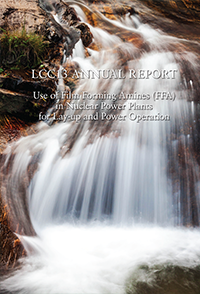
Use of Film Forming Amines (FFA) in Nuclear Power Plants for Lay-up and Power Operation
(LCC13 AR)
This report presents a new corrosion inhibitor based on film forming amines (FFA), which are often referred to as fatty amines or polyamines. FFA can form a mono-molecular hydrophobic film or layer adsorbed on the metal surfaces, that constitutes a homogeneous protective barrier against corrosion by its water-repellent behaviour. FFA belongs to chemical substances of the class of oligo alkylamino fatty amines, the simplest one being the well-known Octadecylamine (ODA). Due to the volatility of the film forming amine, the whole steam water cycle can be protected. The high affinity to surfaces can lead to a slow removal of surface deposits such as loose magnetite and impurities. FFA’s are successfully used as water treatment additives for several decades, in steam water cycles of the VVER type in Eastern Germany and Russia with positive treatment results.
For several years, AREVA has very successfully applied this treatment using a specific procedure in several PWR plants. The purposes are to control the corrosion product transport into steam generators during power operation and for long time lay-up of whole steam water cycle without using hydrazine. Even in a BWR plant this FFA treatment was applied in several parts of steam water cycle with success. This report explains the mechanism of the FFA chemistry treatment and summarises the published information regarding the application results achieved in western nuclear plants.











